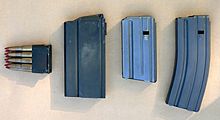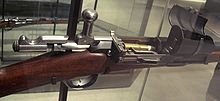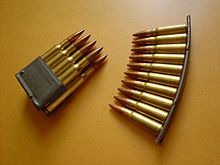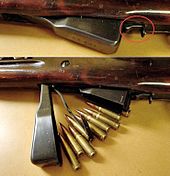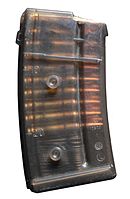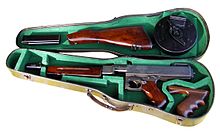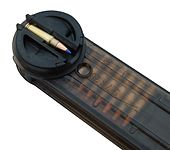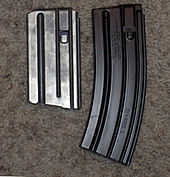- Magazine (firearms)
-
 A staggered-column 9x19mm pistol box magazine; the top image shows the magazine loaded and ready for use while the lower image shows it unloaded and disassembled
A staggered-column 9x19mm pistol box magazine; the top image shows the magazine loaded and ready for use while the lower image shows it unloaded and disassembled
A magazine is an ammunition storage and feeding device within or attached to a repeating firearm. Magazines may be integral to the firearm (fixed) or removable (detachable). The magazine functions by moving the cartridges stored in the magazine into a position where they may be loaded into the chamber by the action of the firearm. The detachable magazine is often controversially referred to as a clip.[1][2]
Magazines come in many shapes and sizes, from bolt action express rifles that hold only a few rounds to machine guns that hold hundreds of rounds. Since the magazine is an essential part of most repeating firearms, they are sometimes subject to regulation by gun control laws seeking to limit the number of cartridges they hold.
Contents
History
The earliest firearms were loaded with loose powder and a lead ball, and to fire more than a single shot without reloading required multiple barrels, such as pepper-box guns and double-barreled shotguns, or multiple chambers, such as in revolvers. Both of these add bulk and weight over a single barrel and a single chamber, however, and many attempts were made to get multiple shots from a single loading of a single barrel through the use of superposed loads.[3] Breech loading designs such as the needle gun, and paper cartridges sped the loading process, but successful repeating mechanisms did not appear until self contained cartridges were developed.
The earliest magazines appeared not on firearms, but rather on air guns. Without the need for powder, the magazine contained only the balls, the power was provided by high pressure air supplied by an air reservoir in the butt of the gun. The Girandoni Air Rifle, dating to around 1780, was fairly typical of the repeating air rifles of the time. The Girandoni held 22 balls in a gravity fed tubular magazine, located beside and parallel to the barrel. Due to the use of a large air reservoir, the rifle could fire all the shots in its magazine before the reservoir was depleted enough to require recharging. Firing was accomplished by raising the muzzle of the gun to allow the balls to fall to the rear of the magazine, sliding a ball from the magazine into the barrel with a sliding breech-block, then cocking the hammer (which was connected to a valve) and firing.[4]
Lever action
The first successful repeater to appear was the Volcanic Rifle, which used a hollow bullet with the base filled with powder and primer (an early form of caseless ammunition) fed into the chamber from a spring-loaded tube called a magazine, named after a building or room used to store ammunition. While the anemic power of the Rocket Ball ammunition used in the Volcanic doomed it to limited popularity, the basic design of the tubular magazine and lever action survive to this day.[5]
The first magazine fed firearm to achieve widespread success was the Spencer repeating rifle, which saw service in the American Civil War. The Spencer used a tubular magazine located in the butt of the gun, rather than under the barrel, and used new rimfire metallic cartridges. The Spencer was successful, but the rimfire ammunition did occasionally ignite in the magazine tube, which would destroy the rifle and potentially injure the user. The lever action Henry and Winchester rifles, evolved from the earlier Volcanic, saw service with a number of militaries, such as Turkey, while Switzerland and Italy adopted similar designs.[5]
A modern removable box magazine was patented for lever-action rifles in 1908 by Arthur Savage and later appeared in a version of the Savage Model 99. Other lever-action rifles used detachable magazines, such as the Winchester 88 and the Ruger 96/44.
Semiautomatic pistol
The first successful semiautomatic pistol, the Borchardt C-93 (1893), incorporated detachable box magazines. Nearly all subsequent semiautomatic pistol designs adopted detachable box magazines.
Bolt action magazine rifle
Beginning in the 1880s, the new bolt action rifle began to gain favor with militaries, and these were often equipped with tubular magazines. The Mauser Model 1871, originally a single shot action, added a tubular magazine in its 1884 update, and the Jarmann M1884, adopted the same year, also used one. James Paris Lee patented a box magazine, which held rounds stacked vertically, in 1879 and 1882, which was first adopted by Austria in the form of an 11mm, straight-pull bolt action rifle of Mannlicher design in 1886; along with this rifle came the cartridge clip, which held 5 rounds ready to load into the magazine.[6][7]
Along with the evolution of the magazine rifle, the military cartridge was evolving too, from large bore cartridges (.40 caliber/10 mm and larger) to much smaller bores, firing lighter, high velocity bullets, along with new propellants. The Lebel Model 1886 rifle, the first rifle and cartridge to be designed for use with smokeless powder, used an 8 mm wadcutter-shaped bullet, loaded from a tubular magazine. This later became a problem as the Lebel's ammunition was updated to use a more aerodynamic pointed bullet, as modifications had to be made to the centerfire case to prevent the point of a bullet from igniting the round in front of it in the magazine.[6]
The bolt action Krag-Jørgensen rifle, designed in Norway in 1886, used a unique rotary magazine that was built into the receiver. Like Lee's box magazine, the rotary magazine held the rounds side-by-side, rather than end-to-end. Like most rotary magazines, it was loaded through a loading gate, this one located on the side of the receiver. The rotary magazine could be loaded with one round at a time, or with a clip of ammunition. While reliable, the Krag-Jørgensen's magazine was expensive to produce, and was adopted by only three countries, Denmark in 1889, the United States in 1892,[8] and Norway in 1894.
The Lee-Metford rifle, developed in 1888, used an eight- or ten-round detachable box magazine. In 1890 the French adopted a new rifle, firing the same 8mm Lebel cartridge, that fed from en-bloc clips; the clips were required for feeding from the internal magazine, and empty clips were pushed from the bottom of the action by the insertion of a loaded clip from the top. Mauser was also developing box magazine-fed (including detachable) variants of his Model 1871 during this time, many of which used en-bloc clips, with models from 1889 through 1893 in various calibers were adopted by various militaries at this time.[6][9]
In the arms race that preceded the start of World War I there were many short lived designs, such as the M1895 Lee Navy and Gewehr 1888, eventually replaced by the M1903 Springfield rifle and Gewehr 98 respectively. The Russian Mosin-Nagant, adopted in 1891, was a good example. It was not revolutionary; it was a bolt-action rifle, used a small bore smokeless powder cartridge, and a fixed box magazine loaded from the top with stripper clips (called chargers by the British), all of which were features that were used in earlier military rifles. What made the Nagant stand out was that it combined all the earlier features in a form that was to last virtually unchanged from its issue by Russia in 1894 through its use by the Soviet Union in World War II. Of the major combatants, only France retained the outdated tubular magazine; all other combatants used rifles that were overall very similar to each other.[10]
An interesting feature of many late 19th and early 20th century bolt action rifles was the magazine cut-off, sometimes called a feed interrupter. This was a mechanical device that prevented the rifle from loading a round from the magazine, requiring the shooter to manually load each individual round as he fired, saving the rounds in the magazine for short periods of rapid fire when ordered to use them. Most military authorities that specified them assumed that their riflemen would waste ammunition indiscriminately if allowed to load from the magazine all the time.[11] By the middle of World War I, most manufacturers deleted this feature to save costs and manufacturing time; it is also likely that battlefield experience had proven the futility of this philosophy.
World War II and later
One of the last new clip-fed, fixed magazine rifles widely adopted that wasn't a modification of an earlier rifle was the M1 Garand rifle. The first semi-automatic rifle that was issued in large numbers to the infantry, the Garand was fed by a special eight round en-bloc clip. The clip itself was inserted into the rifle's magazine during loading, where it was locked in place. The rounds were fed directly from the clip, with a spring-loaded follower in the rifle pushing the rounds up into feeding position. When empty, the bolt would lock open, and a spring would automatically eject the empty clip, leaving the rifle ready to be reloaded. The M14 rifle, which was based on incremental changes to the Garand action, switched to a detachable box magazine.[12]
The Soviet SKS carbine, which entered service in 1945, was something of a stopgap between the semi-automatic service rifles being developed in the period leading up to World War II, and the new assault rifle developed by the Germans. The SKS used a fixed magazine, holding ten rounds and fed by a conventional stripper clip. It was a modification of the earlier AVS-36 rifle, shortened and chambered for the new reduced power 7.62x39mm cartridge. It was rendered obsolete for military use almost immediately by the 1947 introduction of the magazine-fed AK-47 assault rifle, though it remained in service for many years in Soviet bloc nations alongside the AK-47. The detachable magazine quickly came to dominate post-war military rifle designs.[13]
The M1911 semi-automatic pistol set the standard for most modern handguns and likewise the mechanics of the handgun magazine. In most handguns the magazine follower engages a slide-stop to hold the slide back and keep the firearm out of battery when the magazine is empty and all rounds fired. Upon inserting a loaded magazine the user depresses the slide stop, throwing the slide forward, stripping a round from the top of the magazine stack and chambering it. In single-action pistols this action keeps the hammer cocked back as the new round is chambered, keeping the gun ready to begin firing again.
Nomenclature
With the increased use of semi-automatic and automatic firearms, the detachable box magazine became increasingly common. Soon after the adoption of the M1911 pistol, the term "magazine" was settled on by the military and firearms experts, though the term "clip" is often used in its place (though only for detachable magazines, never fixed).[14][15][16] The defining difference between clips and magazines is the presence of a feed mechanism in a magazine, typically a spring-loaded follower, which a clip lacks. Use of the term "clip" to refer to detachable magazines is a point of strong disagreement.[2][17][18][19]
Function and types
All cartridge based single barrel firearms designed to fire more than a single shot without reloading require some form of magazine designed to store and feed cartridges to the firearm's action. Magazines come in many shapes and sizes, with the most common type in modern firearms being the detachable box type. Most magazines designed for use with a reciprocating bolt firearm (tube fed firearms being the exception) utilize of a set of feed lips which stops the vertical motion of the cartridges out of the magazine but allow one cartridge at a time to be pushed forward (stripped) out of the feed lips by the firearm's bolt into the chamber. Some form of spring and follower combination is almost always used to feed cartridges to the lips which can be located either in the magazine (most removable box magazines) or built into the firearm (fixed box magazines). There also two distinct styles to feed lips. In a single feed design the top cartridge touches both lips and is commonly used in single column box magazines. A dual or alternating feed magazine consists of a wider set of lips so that the second cartridge in line forces the top cartridge against one lip. This design has proven more resistant to jamming in use with dual column magazines.[20] Some magazine types are strongly associated with certain firearm types, such as the fixed "tubular" magazine found on most lever-action rifles and pump action shotguns. A firearm using detachable magazines may accept a variety of types of magazine, such as the Thompson submachine gun, which would accept box or drum magazines. Some types of firearm, such as the M249 and other squad automatic weapons, can feed from both magazines and belts.
Box
The most popular type of magazine in modern rifles and handguns, a box magazine stores cartridges in a column, either one above the other or staggered zigzag fashion. This zigzag stack is often identified by the misnomer double-column when in fact, it is a single, staggered column. As the firearm cycles, cartridges are moved to the top of the magazine by a follower driven by spring compression to either a single feed position or side-by-side feed positions. Box magazines may be integral to the firearm or removable.
Box magazines may be metal or plastic. Plastic magazines are sometimes partially transparent so the operator can easily check the remaining ammunition.
- An internal box or fixed magazine (also known as a blind box magazine when lacking a floorplate) is built into the firearm and is not easily removable. This type of magazine is found most often on bolt-action rifles. An internal box magazine is usually charged through the action, one round at a time. Military rifles often use stripper clips or chargers permitting multiple rounds, commonly 5 or 10 at a time, to be loaded at once. Some internal box magazines use en-bloc clips that are loaded into the magazine with the ammunition and that are ejected from the firearm when empty.
- A detachable box magazine is a self-contained mechanism capable of being loaded or unloaded while detached from the host firearm. They are attached via a slot in the firearm receiver usually below the action but occasionally to the side (Sten, FG42, Johnson LMG) or on top (Madsen machine gun, Bren gun, FN P90). When the magazine is empty, it can be detached from the firearm and replaced by another full magazine. This significantly speeds the process of reloading, allowing the operator quick access to ammunition. This type of magazine may be straight or curved, the curve being necessary if the rifle uses rimmed ammunition or ammunition with a tapered case. Box magazines are often affixed to each other with clips, tape, straps, or built-in studs to facilitate faster reloading: aka jungle style.
There are, however, exceptions to these rules. The Lee-Enfield rifle had a detachable box magazine only to facilitate cleaning. The Lee-Enfield magazine did open, permitting rapid unloading of the magazine without having to operate the bolt-action repeatedly to unload the magazine. Others, like the Breda Modello 30, had a fixed protruding magazine that resembled a conventional detachable box but was non-detachable.
Drum
Today, drum magazines are used primarily for light machine guns. In one type, a moving partition within a cylindrical chamber forces loose rounds into an exit slot, with the cartridges being stored parallel to the axis of rotation. After loading of the magazine, a wound spring or other mechanism forces the partition against the rounds. In all models a single staggered column is pushed by a follower through a curved path. From there the rounds enter the vertical riser either from a single or dual drums. Cylindrical designs such as rotary and drum magazines allow for larger capacity than box magazines, without growing to excessive length. The downside of a drum magazine's extra capacity is its added weight. Many drum-fed firearms can also load from conventional box magazines, such as the Soviet PPSH 41 submachine gun, Russian RPK light machine gun and the American Thompson submachine gun. Another notable design is the Beta C-Mag for AR-15 model rifles.
Casket
Another form of box magazine, sometimes referred as a quad-column which can hold a great amount of ammunition retaining the length of a standard magazine although wider. Casket magazines can be found on the Suomi KP/-31, Hafdasa C-4, Spectre M4, QCW-05 and on 5.45x39mm AK rifle derivatives.[21] Magpul has recently been granted a patent for a STANAG compatible casket magazine,[22] and such a magazine was also displayed by SureFire in December 2010 as the High Capacity Magazine (HCM) in 60 and 100 round capacities.[23]
Pan
Often referred to as a drum magazine, the pan magazine differs from other drum magazines in that the cartridges are stored perpendicular to the axis of rotation, rather than parallel, and are usually mounted on top of the firearm. This type is used on the Lewis Gun, Bren Gun[24], Degtyarev light machine gun, American-180 submachine gun and the 2B-A-40 assault rifle. A prototype polymer pan magazine was also developed and tested for use with the RPK-74 light machine gun.
Tubular
Many of the first repeating rifles, particularly lever-action and pump-action types, used a single or multiple tubular magazines that store cartridges end-to-end inside of a spring-loaded tube typically running parallel to the barrel, or in the buttstock. This type of magazine is usually fixed to the firearm, meaning that it is not removed in use. Tubular magazines can still be found today, commonly in shotguns, rimfire rifles, or firearms designed to use round-nose, flat-nose, or otherwise soft-pointed bullets. The tubular magazine was made obsolete for most military purposes with the introduction of pointed "Spitzer" bullets due to the risk of ignition when the bullets tip impacts the primer of the cartridge ahead of it during recoil. Tubular magazines remain common in shotguns, as all shotgun shells are flat tipped.
Rotary
The rotary or spool magazine consists of a star-shaped rotor, or sprocket, actuated by a torsion spring. The magazine may be fixed or detachable. Cartridges fit between the teeth of the sprocket, which is mounted on a spindle parallel to the bore axis, with a torsion spring providing the pressure necessary to rotate the rounds into the feeding position. Rotary magazines are usually of low capacity of ten rounds or less, depending on the cartridge used. The rotary magazine was first used by the Savage Model 1895 & 1899[25] rifles and is still used in a few modern firearm designs, most notably the Ruger 10/22 and the Steyr SSG 69.
Horizontal
In the horizontally-mounted feeding system, the magazine sits parallel to the barrel, fitting flush with the top of the receiver and the ammunition is rotated 90 degrees before being chambered. This feeding system is unique to the FN P90 personal defense weapon.[26]
Helical
Helical magazines extend the drum magazine design so that rounds follow a spiral path, allowing for a very large ammunition capacity in a compact package. However, this requires a complex mechanism and thus increases the likelihood of a firearm malfunction. This type of magazine can be used by the Calico M960, Danuvia VD-01, PP-19 Bizon, PP-90M1, and CF-05 submachine guns.
STANAG
Shortly after NATO's acceptance of the 5.56x45mm NATO rifle cartridge in October 1980,[27] draft Standardization Agreement 4179 (STANAG 4179) was proposed in order to allow the military services of member nations easily to share rifle ammunition and magazines in the interest of easing logistical concerns. The magazine chosen to become the STANAG magazine was originally designed for the U.S. M16 rifle. Many NATO member nations subsequently developed or purchased rifles with the ability to accept this type of magazine; however the standard was never ratified and remains a 'Draft STANAG'[28]
High capacity magazines
The term high capacity magazine is used to describe magazines that exceed a specified definition of "normal" capacity. In many jurisdictions, magazine capacity of certain firearms is legally restricted, such as it was under the United States' Federal Assault Weapons Ban, which defined a magazine capable of holding more than ten rounds of ammunition as a high capacity ammunition feeding device. This law expired in 2004 and there have since been multiple attempts to renew it[29] with no bill reaching the House floor for a vote. An attempt to only renew the limitations on large capacity magazines also failed.[30] Currently, in the United States, six states limit magazine capacities. The limits range from 5 rounds to 30 rounds.[31]
Magazine capacity is often limited by the design of the firearm in such cases as internal, tubular, or rotary magazines. In cases such as a detachable box magazine, capacity is limited only by its design. Some pistol and rifle magazines classified by gun control laws as "high capacity" are the factory standard magazines originally designed for use with their respective firearms. Reduced capacity magazines were created in response to enactment of the bans.[32]
See also
References
- ^ "NRA Firearms Glossary". National Rifle Association. http://www.nraila.org/Issues/FirearmsGlossary/. Retrieved 2008-06-26.
- ^ a b "Gun Zone clips vs. magazines". The Gun Zone. http://www.thegunzone.com/clips-mags.html. Retrieved 2008-06-26.
- ^ Charles Winthrop Sawyer (1920). Firearms in American History, volume III. Cornhill Company, Boston.
- ^ Robert D. Beeman, Ph.D.. "Girandoni style air rifles and pistols - preliminary research presentation.". http://www.beemans.net/images/Austrian%20airguns.htm.
- ^ a b c Hugh Chisholm (1911). The Encyclopaedia Britannica: A Dictionary of Arts, Sciences, Literature and General Information. Encyclopaedia Britannica., entry for Rifle
- ^ Chamber's Encyclopaedia: A Dictionary of Universal Knowledge. W. & R. Chambers. 1891. pp. 720–721.
- ^ United States Army Ordnance Department (1898). Description and Rules for the Management of the U.S. Magazine Rifle and Carbine. p. 36.
- ^ Chuck Hawks. "The 8x50R Lebel (8mm Lebel)". http://www.chuckhawks.com/8mm_lebel.htm.
- ^ Two Thousand Questions and Answers about the War. The Review of Reviews Co.. 1918. p. 88.
- ^ "Firearms Technical Trivia: Magazine cut-offs". Cruffler.com. February 2000. http://www.cruffler.com/trivia-February00.html.
- ^ "Modern Firearms - M14 Rifle". http://world.guns.ru/assault/as15-e.htm. Retrieved 2008-06-26.
- ^ "Simonov SKS carbine (USSR - Russia)". http://world.guns.ru/rifle/rfl01-e.htm.
- ^ United States Army, American Expeditionary Force (1917). Provisional Instruction on the Automatic Rifle, Model 1915 (Chauchat)., translated from the French edition, 1916
- ^ United States Ordanace Dept. (1917). Description of the Automatic Pistol, Caliber .45, Model of 1911.
- ^ United States War Dept (1907). Annual Reports of the Secretary of War.
- ^ "Magazine". SAAMI. http://saami.org/Glossary/display.cfm?letter=M. Retrieved 2008-06-26.
- ^ "Cartridge Clip". SAAMI. http://saami.org/Glossary/display.cfm?letter=C. Retrieved 2008-06-26.
- ^ "Firearms Glossary". National Rifle Association. http://www.nraila.org/Issues/FirearmsGlossary/.
- ^ Weeks, John, World War II Small Arms, London: Orbis Publishing Ltd. (1979), p. 33.
- ^ http://i16.photobucket.com/albums/b24/hybenamon/AVIATION/MISC/GG/881234nn2.jpg
- ^ http://bulletin.accurateshooter.com/2010/06/magpul-invents-new-quad-stack-magazine-for-ars/
- ^ http://www.defensereview.com/dr-exclusive-surefire-60-shot-and-100-shot-ar-ar-15m16-5-56mm-nato-box-magazines-for-infantry-combat-and-tactical-engagements-meet-the-surefire-mag5-60-and-mag5-100-high-capacity-magazines-hcms/
- ^ http://www.cairdpublications.com/scrap/armbitguns/images/Bren%20Guns.jpg
- ^ U.S. Patent 502,018, Magazine-Gun, Filing date: Apr 10, 1889, Issue date: July 25, 1893, Inventor: Arthur W. Savage
- ^ a b Kevin, Dockery (2007). Future Weapons. New York: Berkley Trade. ISBN 9780425217504.
- ^ Watters,Daniel: "The 5.56 X 45mm Timeline: A Chronology of Development", The Gun Zone, 2000-2007.
- ^ "NATO Infantry Weapons Standardization", NDIA Conference 2008
- ^ H.R. 2038, H.R. 3831, H.R. 5099, H.R. 1312, H.R. 1022, H.R. 6257
- ^ H.R. 5099
- ^ Zachary Schurin, Legislative Fellow. "FEDERAL AND STATE RESTRICTIONS ON AMMUNITION TRANSFER AND POSSESSION". http://www.cga.ct.gov/2007/rpt/2007-R-0217.htm.
- ^ Boston's Gun Bible, Boston T. Party ISBN 978-1-888766-06-6, Javelin Press, Durango, CO, April 2002
External links
Categories:- Firearm components
Wikimedia Foundation. 2010.

